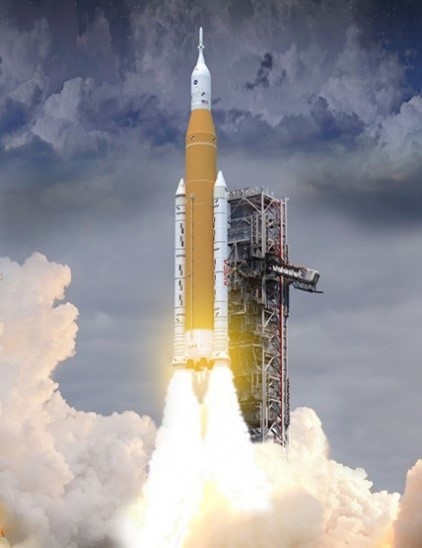Dec 03, 2024 | 565 words | 6 min read
2.3.1. Task 1#
Conservation of space momentum in space vehicles#
Learning Objectives#
By the end of this task, students will apply programming concepts by leveraging absolute and relative cell referencing in MS Excel to automate calculations and dynamically adjust inputs. They will implement key programming principles like loops and conditional logic to efficiently calculate the rocket’s velocity (\(\Delta V\)) as vehicle mass changes. This task reinforces the practical application of programming concepts in engineering, enabling students to solve complex problems with accuracy and precision.
Introduction#

Fig. 2.4 Artemis I launch in Nov. 2022. (Dunbar)#
Rockets work on the principle of conservation of momentum. A rocket is an example of conservation of momentum because the mass of the system is not constant since the rocket ejects fuel at high velocity to provide thrust. Thus, the weight and mass of the rocket are constantly changing during flight (OpenStax, 2016). Because of the changing mass, we cannot use the standard form of Newton’s Second Law of Motion (\(F = m * a\)) to calculate the acceleration and velocity of the rocket (Ideal Rocket Equation). Instead, the Tsiolkovsky rocket equation is used to calculate the change of velocity of the rocket as a result of burning a mass of fuel.
In astrodynamics, the term \(\Delta V\), or “delta V”, is used to describe how much velocity is needed to get from one place in the solar system to another. The Tsiolkovsky rocket equation calculates how much \(\Delta V\) is possible based on a specific propellant exhaust velocity and mass fraction as shown below. Note that this is an ideal equation, which neglects aerodynamic lift and drag.
where,
\(v_e\) = Propellant exhaust velocity (\({\meter\per\second}\))
\(m_0\) = Initial total mass of vehicle (\(\kilo\gram\))
\(m_1\) = Final total mass of vehicle (\(\kilo\gram\))
\(\ln\) is the natural logarithm
Task Instructions#
A team of engineers is designing a space vehicle to launch to low-earth orbit. The team has a propellant with an exhaust velocity (\(v_e\)) of \(\qty{2000}{\meter\per\second}\) and a launch vehicle with an initial total mass (\(m_0\)) of \(\qty{10,000}{\kilo\gram}\). The team plans to use the Tsiolkovsky rocket equation to calculate \(\Delta V\) with this given propellant.
Given a space launch vehicle of known initial mass and propellant exhaust velocity, calculate the change in velocity of the rocket (\(\Delta V\)) necessary to reach a target orbit. Specifically, your tasks are to:
Open the answer sheet
ex2_ind_1_username.xlsx. Save it with your Purdue username replacingusernamein the file name.In the Input Section of the sheet, enter the initial values for \(v_e\) in \({\meter\per\second}\) and \(m_0\) in \(\kilo\gram\)
Under the Calculation Section, populate Table 2.
In the first column, decrement the final total vehicle mass starting at \(\qty{10000}{\kilo\gram}\) and going down to \(\qty{1000}{\kilo\gram}\) by steps of \(\qty{100}{\kilo\gram}\). Use inbuilt formula with relative cell referencing to decrement the values.
In the second column, calculate \(\Delta V\) in \({\meter\per\second}\) for each combination of final and initial vehicle mass. Use absolute and relative cell referencing to perform the calculations so the values of \(v_e\) and \(m_0\) could be changed, and the calculations will automatically update.
Copy the following questions into the Output Section of the spreadsheet and then add your answers.
If a \(\Delta V\) of \(\qty{2000}{\meter\per\second}\) is needed to get to low-earth orbit, what final vehicle mass will just get the vehicle there? Provide an estimate based on your calculations.
If a \(\Delta V\) of \(\qty{4500}{\meter\per\second}\) is needed to get to a geosynchronous orbit, what final vehicle mass will just get the vehicle there? Provide an estimate based on your calculations.
Save the
ex2_ind_1_username.xlsxfile as ex2_ind_1_values_username.pdf displaying the values and ex2_ind_1_formulas_username.pdf displaying the formula.Submit both files to Gradescope.
Note
You can resubmit to Gradescope as many times as you need. Only the latest submission is graded by default.
